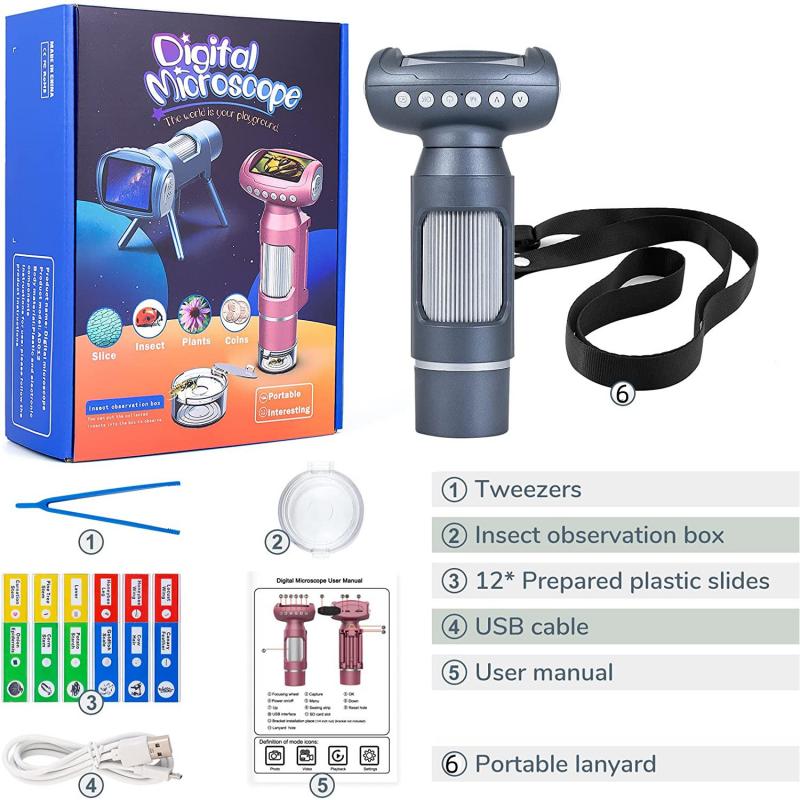What To Put Under Microscope ?
Under a microscope, you can examine a wide range of specimens, including biological samples, cells, tissues, microorganisms, and various materials. For biological samples, you can observe plant and animal cells, bacteria, fungi, and protozoa. Additionally, you can study tissues such as muscle, nerve, or epithelial tissue. Other materials that can be examined under a microscope include minerals, crystals, fibers, and even forensic evidence like hair or fibers. The microscope allows for detailed observation and analysis of the structure, composition, and behavior of these specimens, providing valuable insights into their characteristics and functions.
1、 Microorganisms and Bacteria
Microorganisms and bacteria are fascinating subjects to study under a microscope. When examining these microscopic organisms, scientists can gain valuable insights into their structure, behavior, and interactions with their environment.
One of the most common microorganisms to observe under a microscope is bacteria. Bacteria are single-celled organisms that can be found virtually everywhere on Earth. They come in various shapes, such as rods, spheres, and spirals, and can be stained to reveal their internal structures. By studying bacteria under a microscope, scientists can identify different species, observe their movement, and analyze their growth patterns. This information is crucial for understanding the role of bacteria in various processes, such as nutrient cycling, disease development, and biotechnology applications.
In addition to bacteria, other microorganisms like fungi, protozoa, and algae can also be examined under a microscope. Fungi, for example, can be observed to study their reproductive structures, such as spores and hyphae. Protozoa, on the other hand, can be observed to understand their locomotion mechanisms and feeding strategies. Algae, which are photosynthetic microorganisms, can be examined to analyze their chloroplasts and cell wall structures.
Advancements in microscopy techniques have allowed scientists to delve even deeper into the world of microorganisms. For instance, electron microscopy provides higher resolution images, enabling researchers to study the ultrastructure of microorganisms in greater detail. Fluorescence microscopy, on the other hand, allows scientists to visualize specific molecules or structures within microorganisms by using fluorescent dyes or proteins.
In recent years, there has been a growing interest in studying the microbiome, which refers to the collection of microorganisms that inhabit a particular environment or organism. By using microscopy techniques, scientists can examine the composition and interactions of microorganisms within the microbiome, shedding light on their roles in human health, environmental processes, and disease development.
In conclusion, microorganisms and bacteria are excellent subjects to study under a microscope. By examining their structures, behaviors, and interactions, scientists can gain valuable insights into their roles in various processes. Advancements in microscopy techniques have further enhanced our understanding of these microscopic organisms, allowing us to explore the fascinating world of microorganisms in greater detail.

2、 Cellular Structures and Organelles
When examining cellular structures and organelles under a microscope, there are several key components that scientists focus on to gain a better understanding of cell function and organization. These include the nucleus, mitochondria, endoplasmic reticulum, Golgi apparatus, lysosomes, and cytoskeleton.
The nucleus is often the first structure of interest, as it contains the cell's genetic material and controls cellular activities. Scientists study the nucleus to observe chromatin organization, nucleoli, and nuclear envelope structure.
Mitochondria, known as the powerhouses of the cell, are another crucial organelle to examine. They produce energy through cellular respiration and have their own DNA. Researchers investigate mitochondrial structure and function to understand their role in various cellular processes and diseases.
The endoplasmic reticulum (ER) is a network of membranes involved in protein synthesis and lipid metabolism. Scientists analyze the ER's structure and organization to study protein folding, trafficking, and quality control mechanisms.
The Golgi apparatus is responsible for modifying, sorting, and packaging proteins for transport within the cell or secretion. Researchers examine the Golgi's structure and dynamics to understand its role in protein trafficking and cellular communication.
Lysosomes are membrane-bound organelles involved in cellular waste disposal and recycling. Scientists investigate lysosomal structure and function to study processes such as autophagy and lysosomal storage disorders.
Lastly, the cytoskeleton, composed of microtubules, microfilaments, and intermediate filaments, provides structural support and facilitates cell movement. Researchers examine cytoskeletal components to understand cell shape, division, and motility.
It is important to note that the latest point of view in studying cellular structures and organelles involves advanced microscopy techniques such as super-resolution microscopy, electron microscopy, and live-cell imaging. These techniques allow scientists to visualize these structures with higher resolution and in real-time, providing deeper insights into their organization and dynamics within the cell. Additionally, advancements in molecular biology techniques, such as fluorescent labeling and genetic manipulation, enable researchers to study specific organelles and their functions in more detail.

3、 Tissue and Organ Examination
When conducting a tissue and organ examination under a microscope, there are several key components that should be observed and analyzed. These include the cellular structure, tissue architecture, presence of abnormal cells or structures, and any signs of inflammation or disease.
The cellular structure is of utmost importance as it provides insights into the normal functioning of the tissue or organ. This involves examining the size, shape, and arrangement of cells, as well as their nuclei and cytoplasmic features. Any abnormalities in cell morphology can indicate potential diseases or disorders.
Tissue architecture refers to the organization and arrangement of different cell types within a tissue or organ. This includes the identification of different tissue layers, such as epithelial, connective, or muscle tissue, and their respective functions. Changes in tissue architecture can be indicative of pathological conditions or developmental abnormalities.
The presence of abnormal cells or structures is another crucial aspect of tissue and organ examination. This involves identifying any atypical cells, such as cancer cells, or abnormal structures, such as fibrous tissue or calcifications. These findings can help in diagnosing specific diseases or conditions.
Furthermore, signs of inflammation or disease should be carefully assessed. This includes the presence of immune cells, such as lymphocytes or macrophages, as well as any tissue damage or necrosis. Inflammatory responses can provide valuable information about the underlying cause of tissue or organ dysfunction.
It is important to note that the latest point of view in tissue and organ examination involves the integration of molecular techniques with traditional microscopic analysis. This includes the use of immunohistochemistry, which allows for the identification of specific proteins or markers within tissues. Additionally, molecular genetic testing, such as DNA sequencing or gene expression profiling, can provide further insights into the molecular basis of diseases.
In conclusion, when examining tissues and organs under a microscope, it is essential to focus on the cellular structure, tissue architecture, presence of abnormal cells or structures, and signs of inflammation or disease. By carefully analyzing these aspects, healthcare professionals can gain valuable information about the health and functioning of the examined tissue or organ. The integration of molecular techniques further enhances our understanding of diseases and aids in accurate diagnosis and treatment.

4、 Blood and Body Fluid Analysis
When conducting a blood and body fluid analysis under a microscope, there are several components that can be examined to gain valuable insights into a person's health. These components include red blood cells, white blood cells, platelets, and various types of body fluids.
Red blood cells (RBCs) are responsible for carrying oxygen throughout the body. Under a microscope, their size, shape, and number can be assessed. Abnormalities in RBCs can indicate conditions such as anemia or certain genetic disorders.
White blood cells (WBCs) play a crucial role in the immune system's response to infection and disease. By examining the different types of WBCs and their proportions, doctors can identify potential infections or disorders such as leukemia.
Platelets are responsible for blood clotting. Their count and functionality can be assessed under a microscope to determine if a person is at risk of bleeding or clotting disorders.
Body fluids such as urine, cerebrospinal fluid, or synovial fluid can also be analyzed under a microscope. For example, urine microscopy can reveal the presence of red or white blood cells, bacteria, or crystals, providing insights into kidney function or urinary tract infections.
It is important to note that advancements in technology have expanded the capabilities of blood and body fluid analysis. Automated analyzers can now provide detailed information about cell counts, morphology, and even identify specific pathogens. Additionally, molecular techniques such as polymerase chain reaction (PCR) can be used to detect genetic material from viruses or bacteria.
In conclusion, a blood and body fluid analysis under a microscope allows for the examination of red and white blood cells, platelets, and various body fluids. However, it is essential to consider the latest advancements in technology that have enhanced the accuracy and efficiency of these analyses.






























There are no comments for this blog.